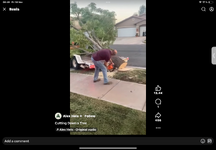T
TheTreeSpyder
Guest
It's without a doubt a hack move, and you'd likely only get away with it on something like (some) pine or spruce etc. Try it on cottonwood or silver maple and they'd go sideways more often than not I would bet.
The point about flexible vs. brittle is good. But if it is a hack move or not i think depends on your repertoire/what all you can pull out of the holster; and if you choose a technique because it is best for the situation (from a wide choice from a given skillset), or you are lazy or if you don't know any better and do it all the time.
Same thing fer other stuff. Maybe you do the same as the next guy on this or that, maybe even same 60% of the time; but mebbe you are worth more because you are pulling that choice from a wider gradient of choices; giving more security and chance for success for customer. Same with doctor, construction, wood finisher etc.





